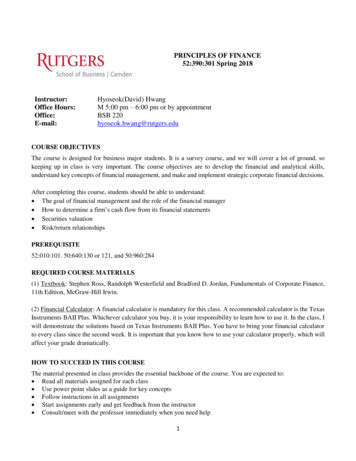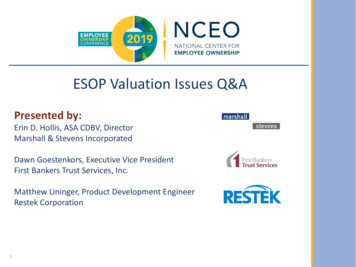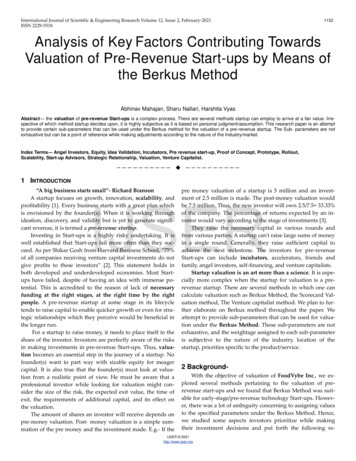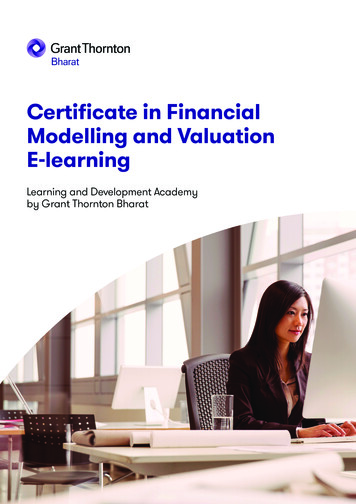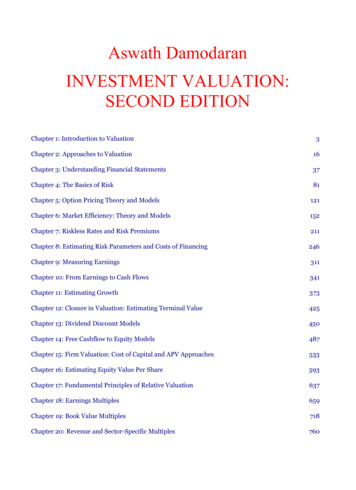
Transcription
The specialist in highly technical, market-drivenbanking and corporatevaluationfinance trainingValuation CoursesBusinessValuation CoursesAll courses can be presented In-House or via Live Webinarweb: redliffetraining.co.ukemail: enquiries@redcliffetraining.co.ukphone: 44 (0)20 7387 4484
Advanced Negotiation Issues in M&ABrochure ContentLocation: LondonDate:Price: . VATBOOK NOWCourse OverviewPUBLIC COURSES Bank ValuationReal Estate ModellingThe Advanced LBO Modelling CourseThe Corporate Finance Modelling MasterclassThe M&A CourseThe Modelling for M&A CourseValuing a BusinessValuing Start Up and Pre IPO CompaniesValuing a Technology CompanyIN-HOUSE COURSES Advanced Business Valuation and Modelling Training Advanced M&A Modelling: A Practical 3 Day Workshop CourseAdvancedValuation - Valuing Rapid Growth CompaniesContent Applied Financial Mathematics in Excel Training Course Emerging Market Bank Modelling & Valuation Excel Auditing Workshop Lease Modelling in Excel Modelling Service-Based Businesses VBA and Macros Valuation Masterclass - Valuing Difficult BusinessesTo book this course or find out more, please click the “Book” button
Advanced Negotiation Issues in M&ABrochure ContentLocation: LondonDate:Price: . VATBOOK NOWCourse OverviewIN-HOUSE COURSES Valuing Commodity Companies and SectorsValuing Cyclical Companies and Sectors - AdvancedValuing Declining and Distressed Companies - AdvancedValuing Early Stage and Start Up Companies - AdvancedValuing Financial CompaniesValuing Emerging Market CompaniesValuing a Pharmaceutical CompanyReal Estate Valuation - South AfricaReal Estate Valuation - Hong KongReal Estate Valuation - UAECourse ContentTo book this course or find out more, please click the “Book” button
Corporate Membership SchemeOur Corporate Membership Scheme gives clients thebenefit of discounted course places with absolutely norestrictions.Clients pay an annual subscription fee of 595 VAT toreceive 20% discount on all public course and conferencebookings irrespective of the numbers booked.You Corporate Membership Scheme can be used oncepayment is received and will be valid for one year.Our Corporate Membership Schemes are not valid on any courses held onan in-house basis and are in line with our standard Terms & ConditionsIf you would like to enquire about one of our Corporate MembershipSchemes then please call or email us for more information.Email: enquiries@rtlimited.co.ukweb: redliffetraining.comTel: 44 (0) 20 7387 4484email: enquiries@redcliffetraining.co.ukphone: 44 (0)20 7387 4484
Advanced NegotiationBankIssuesValuationin M&ADate: 18-19 June 2018, 25-26 Oct Date:2018Location: LondonStandard Price: 1,300 VATLocation: LondonPrice: . VATMembership Price: 1,040 VATBOOK NOWCourseOverviewCourseObjectivesThis training allows participants to build a structured approach to the analysis and valuation of banks. Specifically, through aThistrainingallowsto buildstructuredapproachtheparticipantsanalysis andmixof lecture,casestudiesparticipantsand Excel modellingof aBarclays,the workshopwilltoequipto: valuation of banks.Specifically, through a mix of lecture, case studies and Excel modelling of Barclays, the workshop willequiptheparticipantsto:valuation of banks’ financial statements including the loan book, financial instruments and derivaReviewaccounting and tivesReviewaccountingused forthehedgingpurposes;and valuation of banks’ financial statements including the loan book,financialinstrumentsand derivativesusedBaselfor IIIhedgingpurposes;Furtheradvance participants’understandingof the latestdevelopmentsincluding MREL, counterparty credit risk andlatest leverageand liquidityratios (LCRand NSFR); theFurtheradvanceparticipants’understandingof the latest Basel III developments includingUnderstandingthe key metrics tovalueriska bank,includingperformingall theandstepsof a DividendDiscount(DDM) andMREL, counterpartycreditandthe latestleverageliquidityratios(LCR Modeland NSFR);Analysis usingExcel. MultiplesUnderstandingthekey metrics to value a bank, including performing all the steps of a DividendDiscount Model (DDM) and Multiples Analysis using Excel.Course ContentDay 1Session 1The aim of this session is to provide participantswith an understanding of the financial statementsof a bank. The focus is on the banking bookand financial instruments. The reporting andvaluation of derivatives is also discussed. Banks’ financial statements overview Accounting for loans Non-performing loans Understanding impairments vs. write-off Incurred losses (IAS 39) has been replaced by expected losses (IFRS 9)CourseContent Accounting for financial instruments Lastest IFRS 9 implications: Amortisedcost, FVTPL and FVTOCI Level 1, 2 and 3 valuations Impairments of financial instruments Accounting for derivatives Hedge accounting: fair value, cash flowand net investment Netting derivative assets and liabilitiesCase study: Barclays Financial StatementsSession 2Fundamentals of Regulatory CapitalThroughout this module, participants review thecurrent regulatory requirements, in particularTier I and Tier II capital ratios and understanddetailed computations. Overview of regulatory framework Overview of Basel I, II and III and latestBasel IV updates Overview of calculating available and required capital Common Equity Tier 1 (CET1), Tier 1,Tier 2 and Total capital Key reconciliation items from IFRS BookEquity to CET1: minority interests, deferredtax, changes to investment portfolio, etc. Overview of calculating risk weighted assets(RWAs): credit risk RWA, counterparty risk,market risk and operating risk with the latestBasel IV requirements- Standardised floor of 72.5% based onstandardized approach- Simultaneous reduction in standardisedrisk weights for low risk mortgage loans Overview of key capital, liquidity and fundingratios Tier 1 and total capital ratios Leverage ratios Liquidity coverage ratios (LCR) and Netstable funding ratios (NSFR)Case study: Barclays Regulatory RatiosReviewDay TwoSession 3Forecasting and Modelling BanksBased on the financial statements and publiclyavailable regulatory information of Barclays,participants forecast its financial performancebased on its historical statements. Modelling and forecasting the balance sheet:deposit or loan-driven? The loan and trading book Funing requirements and mix: deposit vs.wholesale funding Growth in funds under management Modelling and forecasting the income statementTo book this course or find out more, please click the “Book” button
Advanced NegotiationBankIssuesValuationin M&AContinuedDate:Location: LondonPrice:. VATBOOKNOWBOOK NOWCourse ContentOverview Understanding the income statement driversNet interest income and marginNon-interest incomeForecasting loan impairment through thecredit cycleOperating costsTaxModelling and forecasting regulatory capitalRisk weighted assetsRequired and available capital under Basel I,II or IIILiquidity requirements and stable fundingrequirementsForecasting dividends (payout ratio and/orminimum capital requirement)Ratio analysis and key performance ratiosCase study: Financial Modelling of Barclayson ExcelSession 4Bank ValuationFollowing the forecasting of the bank’sperformance, this session focuses on the DividendDiscount Model (“DDM”) and key multiples ofBarclays.CourseContent Free cashflow to equity mode Present value of future dividends Cost of equity for banks Terminal value: review of potential approaches (key parameters or RoE) Sensitivity analysis Banking trading multiple P/BV and adjustment to BV explained P/E, dividend yieldCase study: DDM and Multiples of Barclayson ExcelTo book this course or find out more, please click the “Book” button
Advanced NegotiationReal EstateIssuesModellingin M&ADate: 13-15 Mar 2018, 28-30 Nov Date:2018Location: LondonStandard Price: 1,700 VATLocation:LondonPrice:Price:. VATMembership 1,360 VATBOOK NOWCourse OverviewCourse OverviewCourse MethodologyThis course will teach you all the available techniques and how to practically apply them through theuse of Excel, Estatemaster and Argus. An extensive use of case studies will be adopted to illustratethe principles covered. Ultimately delegates will get practical tips on layout and style in building andanalysing user-friendly models which are available as additional benefits of the course.Who Should AttendThis course is designed for delegates who are seeking to improve their technical real estate modellingskills in Excel. Bankers and financiers involved in real estate Directors and business development executives from corporates, equity sponsors and consultanciesCourse ContentDay 1: Building Blocks of Real EstateModellingUsing Excel for modelling Worksheet organization Data input, management and verification Use of colour/add-ins Naming of cells Location of input variables Reviewof Excel functions and their useCourseContent Macros and their use Goal seeking Optimisation Circularity and how to resolve it Working with range names Graphs and charts What is needed from Excel and what issuperfluous Principles of spreadsheets and workbooksCase Study: Evaluating good and badExcel financial modelsEquity valuation Equity NPV/ IRR and project IRR XNPV, XIRR, MIRR Modelling cash flow and ratios: Allowing for accountancy in real estatemodels: Depreciation Tax SPV accounting Capital allowancesCase Study: Valuation and Cash FlowmodelsFundamentals of Real Estate Models Objectives of real estate models Structure of real estate model design Dealing with escalation/inflation Monthly, quarterly and annual modelling Design, testing and feedback Model sensitivity and auditing Revenue and cost modelling Cash adequacy, recourse, standby and liquidity Financial coverage ratios and the bank perspective What are the software choices for real estatedevelopment? Estatemaster vs Argus vs ExcelDemonstrations: Argus and EstatemasterReal Estate development modelling issues Architects, planners and real estate development Concept and objectives of Construct andSell (CS) models Assumptions required for CS models Development cashflow corkscrews Sales prices and taxes Valuation and risk analysis of real estatedevelopment modelsCase Study: Examples of real estatedevelopment modelsReal Estate investment modelling issues Limited recourse and loan terms and covenants in real estate lending Structuring and financing solutionsTo book this course or find out more, please click the “Book” button
Advanced NegotiationReal EstateIssuesModellingin M&ADate:ContinuedLocation: LondonCourse Overview Real estate investment finance experienceCourseOverviewworldwide Objectives of real estate investment models Buy and Let (BL) discounted cash flowmodelling issues Risk analysis for real estate investmentmodelsCase Study: Review of several real estateinvestment models and their decisionmaking inputDay 2: Building a Construct and Sell (CS)ModelBuilding a real estate model. Based on a realexample, provided by an equity investor in a realestate transaction, delegates will construct anduse a model for the transaction. The exercisewill include: Project ReviewAnalysing the inputsCosting constructionDealing with input prioritiesData plausibilityModelling loan drawdownSales price projections and cap ratesEstablishing value from a construct and saletransactionPrice:. VATBOOKNOWBOOK NOWDay 3: Building a Discounted Cash FlowModel (DCF) modelDelegates will continue with the real examplefrom Day 2 to construct a model based onthe assumptions of construction, with revisedassumptions, and leasing out. Revising construction inputs Loan assessment criteria PGI, EGI and NOI in the model Forecasting NOI and operating expenses Modelling loan amortization IRR NPV and other valuation analysisMonte Carlo and real estate modelling Methods of handling risk What is Monte Carlo analysis? Worked examples of Monte Carlo analysis Applying Crystal Ball to CS and CL Models Analysing the results Presentation of Monte Carlo results to seniormanagementCourse ConclusionCourse ContentTo book this course or find out more, please click the “Book” button
Advanced LBOAdvancedModellingNegotiation- A PracticalIssuesWorkshopin M&ADate: 28-29 Jun 2018, 15-16 Nov Date:2018Location: LondonStandard 1,300 VATLocation:LondonPrice:Price:. VATMembership Price: 1,040 VATBOOK NOWCourse OverviewThis course covers the key elements of modelling in an LBO analysis. Participants will value the targetbusiness using historic data and available equity research. The valuation process will incorporateabsolute and relative valuation techniques. Once the target business has been valued, participantswill be introduced to LBO analysis and construct an LBO model. The LBO modelling analysis will bedeveloped by assessing the debt capacity of the business to determine the range of capital structuresavailable for the transaction and how credit analysis is used in the LBO modelling process.The participants will then cover more complex LBO instruments such as warrants and PIKs, how theycan be incorporated into an LBO structure and how to calculate returns to each of the equity and debtproviders. Participants will model a more complex capital structure and calculate exit values and theIRRs generated by each investor. Using the integrated model participants will then analyse variousscenarios (management case, base case, payout case) to derive the optimum financing structuretaking into account the financial constraints of each investor.The participants will then undertake an adjusted present value (“APV”) analysis to determine wherevalue has been created in the LBO transaction using an APV model and finally look at a recoveryanalysis for a failed LBO transaction.Case Study: The participants will use a variety of case studies and exercises during the twodays, based on publically quoted and generic companies.Course ContentLeverage Overview Background to the LBO market Introductory theory - The effect of leverageCourseContenton firm valueValuing the Target Sourcing information – Historic and forecastdata Analysing equity research Key attributes of broker analysis Pluses and minuses of equity research Building a DCF valuation using equity research Modelling the stand alone valuation DCF valuation Use of multiples in valuation (EV/EBIT, EV/EBITDA)Case Study I: Participants model the standalone valuation of the target using historicdata and equity researchLBO Modelling Overview Key elements of an LBO model Comparing and contrasting DCF and LBOmodels Sources and uses of funds From stand alone valuation to LBO analysisCase Study II: Participants use the standalone valuation of the target to completean LBO modelAssessing debt capacity for LBO financing Financial interdependencies Financing growth Sustainable debt Target debt capacity assumed in a WACCcalculation, debt capacity and interestcover Debt capacity in LBOs Debt capacity multiples in practice andcredit analysisCase Study III: Modelling the debtcapacity of the target using multiple andcredit analysisCapital providers and their typicalcharacteristics Institutional and management equity Traditional/new lenders Senior tranche profilesTo book this course or find out more, please click the “Book” button
Advanced LBOAdvancedModellingNegotiation- A PracticalIssuesWorkshopin M&ALocation: LondonDate:ContinuedPrice: . VATBOOK NOWCourse ContentOverview A, B, C, RCF Subordinated tranche profiles Second lien Mezzanine (with/without warrants) PIK High yield bonds More complex issues – warrants and options Typical LBO transaction sensitivity analysis,management, base and payout casesCase Study IV: Modelling a more complexcapital structure with various scenarioscalculating exit value and IRR for each ofthe capital providersAssessing value creation in LBOtransactions – APV analysis Key components of an APV valuation Unlevered value Value of the tax shield Direct and indirect cost of leverage APV valuation and DCF valuation APV valuation in a steady state Calculating AP in a steady growth environment Incorporating APV analysis in an LBO transaction analysisCourse ContentCase Study V: Where has value beencreated, modelling APV analysis for an LBOtransactionTo book this course or find out more, please click the “Book” button
Masterclassin M&ALocation: LondonDate: 25-29 Jun 2018, 12-16 Nov Date:2018Standard Price: 3,000 VATLocation: LondonPrice: . VATMembership Price: 2,400 VATBOOK NOWCourse OverviewOn days one, two and three the course covers the key elements of an acquisition or merger, fromthe initial stand-alone valuation of the target to the more complex accounting and modelling issuesto be considered and finally analysing and assessing the value created by synergy benefits andleverageThis course is run in an interactive, participative format, where participants learn by doing. The keyconcepts covered in the main teaching sessions are punctuated and illustrated by detailed case andmodelling work.The approach has been designed to equip participants to put key concepts into practical useimmediately.Participants will be led through a comprehensive review of analysis practices, from initial principlesthrough to more advanced techniques that are used in transaction analysis.As part of their work on this course participants model transactions based on real-life companiesand scenarios.On the last two days participants will cover the key elements of modelling in an LBO analysis.Participants will value the target business using historic data and available equity research. Thevaluation process will incorporate absolute and relative valuation techniques. Once the targetbusiness has been valued, participants will be introduced to LBO analysis and construct an LBOmodel. The LBO modelling analysis will be developed by assessing the debt capacity of the businessto determine the range of capital structures available for the transaction and how credit analysis isused in the LBO modelling process.The participants will then cover more complex LBO instruments such as warrants and PIKs, howthey can be incorporated into an LBO structure and how to calculate returns to each of the equityand debt providers. Participants will model a more complex capital structure and calculate exitvalues and the IRRs generated by each investor. Using the integrated model participants will thenanalyse various scenarios (management case, base case, payout case) to derive the optimumfinancing structure taking into account the financial constraints of each investor.The participantswill then undertake an adjusted present value (“APV”) analysis to determine whereCourseContentvalue has been created in the LBO transaction using an APV model and finally look at a recoveryanalysis for a failed LBO transaction.Course ContentDays 1, 2 & 3M&A model build up: the starting point Modelling integrated financial statements Model structure Key forecast ratios Sourcing and cleaning historic data What makes a good model?Modelling – integrating financialstatements: participants complete apartially-developed financial model for apublic quoted company which integratesP&L, balance sheet and cash flow. Thiscompany will be the target company usedin the merger analysisModelling stand-alone valuation Overview of valuation methodologies What do investment banks do? What methodologies could we use? How should we define firm value? Equity vs.enterprise value Calculating free cash flow before financing Understanding and calculating WACC Discussion – calculating WACC Key issues with a two stage DCF valuation –WACC and terminal value assumptionsModelling - valuation: participantscalculate the cost of capital and completea DCF valuation for the target company,producing a stand-alone valuation as across check to the acquisition priceDay TwoAccounting for corporate transactions Different types of transaction and how theyare modelled in practiceTo book this course or find out more, please click the “Book” button
Masterclassin M&ADate:ContinuedLocation: LondonPrice: . VATBOOK NOWBOOK NOW Consolidation accounting under the currentCourseIFRS Overview3 an IAS 27 Change of control triggers Accounting for non-controlling interests(“NCI”) Accounting for disposals Partial disposals – creating a NCI Partial disposal – loss of control Recent changes to acquisition accountingunder IFRS Definition of control Calculation of goodwillModelling: delegates complete a variety oftransaction models incorporating all typesof corporate transaction and calculatethe effect of a transaction on a set ofconsolidated accounts in preparation toperform a merger analysis with the targetbusiness and an acquirerAcquisition finance Types of transactions and synergies Availability of synergies and problems inachieving them Methods available for valuing synergies Key differences between public vs. privatedeals, recommended vs. hostile bids Choices for growth: acquisition vs. organicvs. joint venture Defence strategies for target companiesCourseContentresistinga hostile bidCase study: Participants calculatesynergies for a case companyDay ThreeStructuring acquisition finance Once price has been agreed, how is it paid?Cash vs. Shares Financing choices for raising cash for anacquisition: Debt vs. Equity Calculating the success of a deal, accretionvs value creation The nature of equity instruments The different risks and rewards accruing todifferent parties The impact of loan stock, convertibles andpreference shares on WACC Calculating returns to key participantsCase study: Calculating accretion/dilutionand the effect of hybrids on cost of capitalMerger modelling case study Completing a merger model Getting to DCF valuation for the combinedbusiness Combined WACC Valuing operating synergies Valuing financing synergies Accretion/dilution analysis vs wealth creation Sense-checking the output and adjusting thecapital structureModelling – bringing it all together:participants complete a complex mergermodel for an acquisition of the targetbusiness incorporating synergy analysisand varying capital structure. Thetransaction is analysed on an accretion/dilution analysis and a wealth creation/return on capital analysisAt the end of this session participantswill have a working acquisition modelincorporating a variety of different formsof transaction analysisCourse conclusion: best practice intransaction analysis Participants will have improved their understanding of and have had experience ofmodelling mergers and acquisitions fromfirst principles Simple and clear reference Excel models providing participants with a platform forfuture internal modelling efforts and aidingdecision making Participants who, at the end of the course,understand the drivers on transactions andhow transactions can be modified to suit thevarious partiesDays 4 & 5Leverage Overview Background to the LBO market Introductory theory - The effect of leverageon firm valueValuing the target Sourcing information – Historic and forecastdata Analysing equity research Key attributes of broker analysis Pluses and minuses of equity research Building a DCF valuation using equity research Modelling the stand alone valuationTo book this course or find out more, please click the “Book” button
Masterclassin M&ADate:ContinuedLocation: LondonPrice: . VATCourse Content DCFvaluationCourseOverview Use of multiples in valuation (EV/EBIT,EV/EBITDA)Case Study I: Participants model thestand alone valuation of the target usinghistoric data and equity researchLBO Modelling Overview Key elements of an LBO model Comparing and contrasting DCF andLBO models Sources and uses of funds Key drivers in an LBO model From stand alone valuation to LBO analysisCase Study II: Participants use the standalone valuation of the target to completean LBO modelBOOK NOWBOOK NOWfor each of the capital providersAssessing value creation in LBOtransactions – APV analysis Key components of an APV valuation Unlevered value Value of the tax shield Direct and indirect cost of leverage APV valuation and DCF valuation APV valuation in a steady state Calculating AP in a steady growth environment Incorporating APV analysis in an LBO transaction analysisCase Study V: Where has value beencreated, modelling APV analysis for an LBOtransactionAssessing debt capacity for LBOfinancing Financial interdependencies Financing growth Sustainable debt Target debt capacity assumed in a WACCcalculation, debt capacity and interestcover Debt capacity in LBOs Debt capacity multiples in practice andCoursecreditContentanalysisCase Study III: Modelling the debtcapacity of the target using multiple andcredit analysisCapital providers and their typicalcharacteristics Institutional and management equity Traditional/new lenders Senior tranche profiles A, B, C, RCF Subordinated tranche profiles Second lien Mezzanine (with/without warrants) PIK High yield bonds More complex issues – warrants and options Typical LBO transaction sensitivity analysis, management, base and payout casesCase Study IV: Modelling a morecomplex capital structure with variousscenarios calculating exit value and IRRTo book this course or find out more, please click the “Book” button
Mergers& Acquisitions(M&A) inCourseAdvancedNegotiation IssuesM&ALocation: LondonDate: 15-18 May 2018, 22-25 Oct Date:2018Standard Price: 2,400 VATLocation: LondonPrice: . VATMembership Price: 1,920 VATBOOK NOWCourse OverviewThis four day M&A course covers all aspects of buying, selling, valuing private companies andmanagement buy-outs.The first day of this mergers & acquisitions course covers creating shareholder value through the pursuitof a successful M A strategy has been shown to be a far from risk-free activity. Buyers overpayingor using inappropriate financing methods can lead to destruction of value and in some cases financialdistress. Day one covers topics of risk and return, process, investigation and integration as a practicalguide to identifying and negotiating acquisitionsThe second day of this mergers & acquisitions course covers the practical steps that are required to plan,negotiate, and close a successful sale. Valuing the business to be sold and the effective presentation ofthe commercial attractions of the business are key elements, as are choosing the appropriate advisersand running a competitive auction.The third day of this mergers & acquisitions course covers the topics of the financial ratios used incomparable company valuation, creative accounting, and the cost of capital, forecasting and discountingfree cash flow. Exercises include the use of an Excel spreadsheet as input to valuing a business and,accordingly, attendees are requested to bring a laptop to the course.The fourth day of this mergers & acquisitions course covers the principles and practicalities involved inarranging and negotiating a management buyout. In addition to the legal issues to be addressed, theuse of bank debt and other financial instruments is examined in the context of developing a workablestructure for the deal.Course ContentDay 1The Drivers of Growth The needto deliver shareholder valueCourseContent The company life cycle The importance of directors recognisingthe value curve Risk and return Relating risk to the life cycle phase of thecompany / target Product market growth and decline Evaluating niches, substitutes, value ininnovationREVIEW: Comparison and contrast of thelifecycle of three different companies,highlighting how success or failure withacquisitions has determined their fate ICI Debenhams GKNGrowth through Acquisition Assessing the alternatives Investment JV AcquisitionDISCUSSION: Advantages anddisadvantages of each approach Determining the acquisition Market objectives Consolidating a fragmented market Building the value proposition Management issues Assessing cultural fit Price parameters Knowledge of comparative deals Opportunity cost Is it a “now or never” dealREVIEW: The Ansoff Matrix, a handy wayto categorise potential risks in acquisitionstrategies Pitfalls to avoid Realism of synergies Defining a synergy Identifying the likely presence of a synergy Risks of prediction, cost and achievement Accounting standards Who is the auditor, what principles are followed GAAP versus IFRS Judging forecasts Scepticism rules Commercial factors The target’s history Recurring revenue Intellectual propertyTo book this course or find out more, please click the “Book” button
MergersAdvanced& AcquisitionsNegotiation Issues(M&A) inCourseM&AContinuedDate:Location: LondonCourse Content CustomerbaseCourseOverviewCASE STUDY: Reviewing companyinformation to arrive at a value, taking intoaccount qualitative and strategic factorsThe Acquisition Process Establishing acquisition criteria Target size and affordability Potential synergies Market / competitor impact Regulatory factors Shareholder impact Due Diligence Investigation prior to offer Public sources Private sources Verification Contracts Accounts Pensions Employee disputes LitigationCASE STUDY: Reviewing summaryinformation on a company to determinewhich areas need investigation and whoshould have responsibility for the task Deal structuring Earn-out / deferred consideration Non-compete undertakings Warranties and indemnities Disclosure lettersCourse ContentAcquisition Integration Success / fa
Business Valuation Courses web: redliffetraining.co.uk email: enquiries@redcliffetraining.co.uk phone: 44 (0)20 7387 4484 valuation training Valuation Courses All courses can be presented In-House or via Live Webinar. 7RERRNWKLVFRXUVHRU¿QGRXWPRUH SOHDVHFOLFNWKH³%RRN EXWWRQ Course Content .
